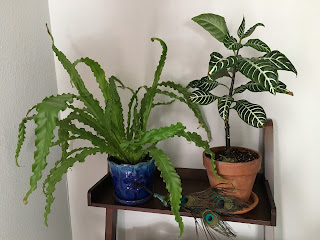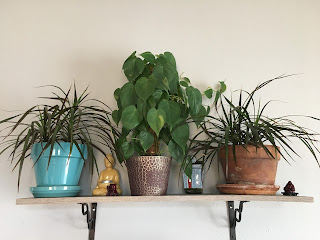By Nora Seilheimer
My husband thought I was nuts for naming all of our
houseplants.
Just call them what
are: the fern, the peace lily, the vine-y thing in the corner, he said. They don’t need names.
Well, how else will
they know we’re talking to them?
Jesus, you’re going to
talk to them?
 |
| Birdie (birds nest fern) and Zenobia (zebra plant) |
Truth be told, I’ve always been ashamed of my black thumb. I
feared it was proof I wasn’t a grown-up yet, that I was incapable of taking
care of another living being. Before we moved to New Orleans two years ago, I
managed to kill every green thing in my Chicago, cave-like apartment. I could
blame such deaths on the harsh winters, my broken radiator, or lack of natural
light, but the common factor was me. It was always me. So when we moved to New
Orleans, a much warmer, kinder climate, and into an apartment with 8-foot
windows on three sides, I knew my lineup of excuses no longer applied. It was
time to be an adult.
It was time to keep green things alive.
Contrary to what my husband thinks, I’m not crazy for
wanting to talk to our plants. In 2009 The Royal Horticultural Society (RHS) performed
a month-long study that suggests plants love a good conversation, and they prefer
having them with women. (Can you blame them?)
Colin Crosbie, Garden Superintendant and leader of this RHS
study, and his team hooked up headphones to the pots of ten tomato plants. Each
set of headphones played either a recording of a man or a woman’s voice reading literature
or scientific texts aloud. Two more tomato plants were not hooked up to
headphones to act as control for the experiment. All twelve plants were of the
same variety, planted in the same soil and given the same care throughout the
month. After thirty days passed, the plants listening to female voices grew one
inch taller than those listening to male voices. All ten plants listening to
voices grew at a faster rate than the two not listening to voices, some up to three inches taller.
To bring it back to American soil, Discovery Channel’s Mythbusters performed their own
experiment,
 |
| Claire (spider plant ), Jack (philodendron), and Tammy (spider plant) |
But what is it about our voices that encourages plants to
grow?
Researchers at South Korea’s
National Institute of Agricultural Biotechnology explain that our voices
are a type of sound and therefore carry their own vibration. This vibration stimulates
the same genes in plants that respond to light and ignite photosynthesis, or
the process by which plants turn light into energy. The vibration of our voices
encourages our plants to create energy and use it to grow taller and stronger.
 |
| We just got this sansevieria a couple days ago. We will choose a name after we get to know them better. |
While proving my adulthood by naming and talking to my
plants is supported by these studies, this initiative was not inspired by any
of them. Instead this practice in naming and conversation took root in the good
ol’ Golden Rule: treat others the way you wish to be treated. I know if I was a
plant (for the record, I’d be a bird’s nest fern), I’d like my caretaker to
give me a name and tell me about their day.
I suspect my husband would, too.
---
Sources used:
No comments:
Post a Comment